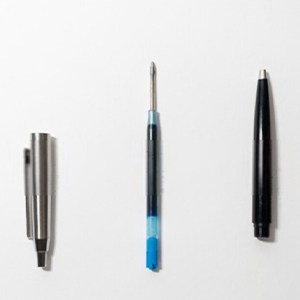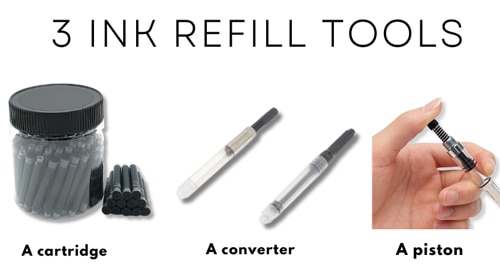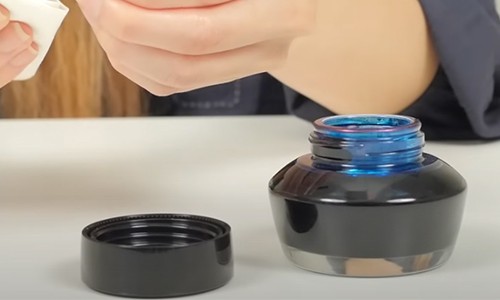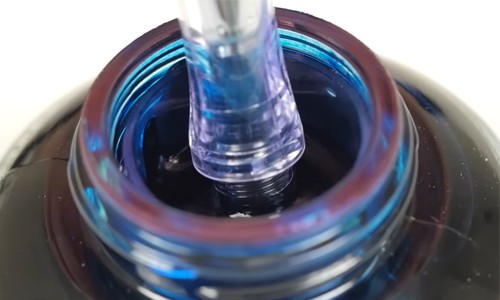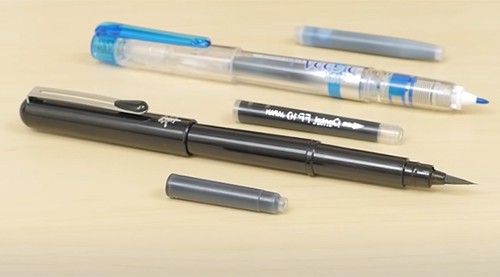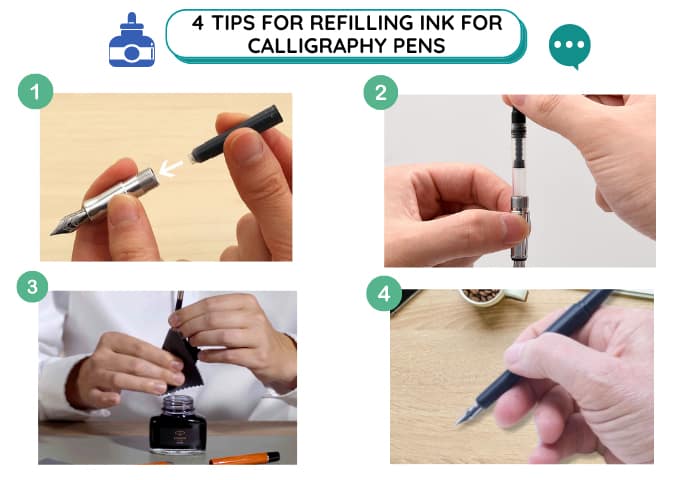Calligraphy pens offer numerous options: monoline, broad-edge, pointed, and brush pens. They create different writing styles that can make you feel overwhelmed if you’re using them for the first time. Hence, we’d recommend you select these pens carefully to match your desires.
Notably, calligraphy pens are also compatible with specific filling mechanisms. Hence, you need to understand them thoroughly to ensure you can refill a calligraphy pen properly.
In case you are a newbie in this field, don’t worry. We’ll walk you through detailed instructions on how to put ink in a calligraphy pen to help the ink flow continuously. Check them out!
Table of Contents
Step-by-step to Put Ink in a Calligraphy Pen
Step 1: Disassemble refillable calligraphy pens.
Detach components of a calligraphy pen, including the cap, grip section, and barrel, but take note of the following:
- There are a few pens whose barrels you don’t need to twist off due to their self-filling systems.
- If the pen has an integrated button or piston, take off the blind cap covering it.
- For cartridge pens, you can tap several times on the barrel to remove anything stuck inside such as an empty spacer.
Step 2: Determine filling systems and clean the pen.
There are different ways to load a calligraphy pen. Hence, determine which type of Manuscript calligraphy pen you use to follow the correct guide (this applies to other brands as well).
- A cartridge has disposable plastic ink reservoirs.
- A converter is equipped with a squeeze filler.
- A piston has a plunger.
If you change ink colors, clean the nib before you put ink in a fountain pen to eliminate dried ink blocking constant flows, prevent the nib from being damaged, and avoid mixing colors when writing.
After detaching the pen’s parts, submerge the nib into cool water and let it sit for 15 minutes.
Take the nib out of the water and wipe it with a soft towel to remove the remaining liquid.
Step 3: Refill a calligraphy pen.
Remember to choose a suitable calligraphy ink that’s thick, dense, and quick-drying. Moreover, the ink shouldn’t contain pigments or be waterproof. Otherwise, the ink will not flow consistently due to blocks. Then, learn the filling methods below:
With a Piston Filler Ink Reservoir
The piston pen allows you to save money and effort when you refill a pen with ink, thanks to its large ink holder.
Step 1: Prepare workplace
Place the ink bottle on a flat surface to prevent it from falling over. Then, spread a towel or paper under the bottle to absorb ink in case of any leakage.
Step 2: Draw ink
- Move the piston to the bottom of the ink reservoir by screwing the knob at one end of the pen.
- You should submerge the nib and grip section into ink and ensure the breather hole is dipped completely. If there is only the nib immersed in ink, it will be difficult to draw sufficient fluid for the reservoir, so there will be more air than ink inside.
- Start to rotate the knob in the opposite direction compared to the above step to elevate the piston. Note that you should do this carefully and slowly to draw ink with the least air.
- Repeat this step several times until the ink holder is full.
Step 3: Reserve ink
Once done, take the nib out of the bottle while holding the pen upright. Don’t forget to release around 5 drops to the bottle. Wipe the outer part of the pen clean before putting the cap back on.
With Ink Cartridges
Ink cartridges are disposal ink tubes without syringe. Therefore, replacement ink for these pens is the simplest to use compared to the two other methods. You can follow the same steps to fill ink in Parker fountain pen.
Step 1: Choose the proper ink cartridge.
- It should be highlighted that not all ink cartridges are compatible with all pens. Almost all manufacturers produce regular international cartridges (short or long), but several make specific ink holders for their pens. You can check existing cartridges and purchase accordingly.
- Depending on your pen design, you can remove the old cartridge by pulling it out from the grip section or unscrewing it.
Step 2: Put ink cartridge in calligraphy pen
You need to install ink cartridge to the backside of the nib. Find the cartridge end with a cup-like rim that fits the opening end of the grip section. Then, put these points together by pressing them.
When you hear a click sound, they are attached properly, and the seal of the cartridge will be punctured to release ink flow.
If you don’t want to purchase a single-use ink cartridge, you can refill it with a syringe.
- Clean ink by adding water to the cartridge, then remove the dirty water with a syringe. To avoid diluting the new ink, use a Q-tip to soak leftover ink and water.
- Use the syringe and its needle to draw around 1 millimeter or more ink from the ink container and put it into the cartridge.
- Follow the previous steps to insert the cartridge into the nib.
With Converters
Step 1: Set up the working area
You can follow the first method to prepare your working zone.
Step 2: Check the converter
- Ensure the converter is attached to your pen properly; if not, it’s likely impossible to load ink to the pen.
- In case your ink cartridge has a similar size to the converter, you can replace it with the converter to turn it into a refillable pen.
Step 3: Release air
Depending on each type of converter, you can remove the air from the reservoir in 2 ways before or after you dip the pen into ink. If you choose the latter, bubbles can appear.
- Piston: Screw the knob in an anticlockwise direction or push the piston down to eliminate air and move the piston to the bottom.
- Squeezer: You just need to squeeze the sac and hold it.
Step 4: Insert ink
- We’d recommend you follow step 1 for the piston filler to know how to dip the pen correctly to suck ink fully.
- Different converter styles require various methods to pump ink. During this process, the appearance of air in the reservoirs is inevitable. That said, you should do this step slowly to reduce the air as much as possible.
- Piston: Rotate the knob clockwise to lift the piston and draw ink. If you’re using push-type pistons, press the button quickly to suck ink.
- Squeeze: Compress the sac to get rid of air and release it carefully to load ink.
- Repeat this process until the reservoir is full.
Step 5: Assemble a calligraphy pen
- Pick a good tissue paper to wipe the ink residue on the nib and the grip section. Check the nib before writing to remove any paper bits clinging to have smooth writing strokes.
- Now, it’s time to put the pen’s parts together.
In Other Calligraphy Pens – Dip Pens and Oblique Pen
Step 1: Arrange the working area
You don’t need to disassemble the pen’s components, but prepare your working area as instructed in the previous part and open various colored ink bottles if needed.
Step 2: Dip the pen and write
- These pens aren’t designed with ink reservoirs. You must submerge the nib into the ink with the ink level exceeding the vent of the nib a bit.
- Remove abundant ink on the nib by gently shaking it to prevent ink smudges on the paper. Then, you can write with your pen and dip it when needed.
Other Tips When Putting Ink in a Calligraphy Pen
- You should insert a new ink cartridge with strong pressure without worrying about breaking the pen. If not, the ink cannot contact closely with the nib to produce ink flow.
- In case your pen cannot suck ink properly, we’d suggest you check whether the converter is installed to the grip section and the nib is immersed in ink correctly.
- If the ink bottle mouth is quite narrow to soak a dip pen in, you can use a paintbrush to take ink from the bottle and wipe it over the pen’s side for writing.
- Your pen won’t work well immediately after you load ink. You should let it stand upright with the nib downward for several minutes to ensure capillary action works effectively.
In urgent cases, you can squeeze the ink reservoir or cover the nip with a paper tissue and shake the pen slightly to speed up the action. Another way is to immerse the nib in lukewarm water. To check if the pen works properly, you can scratch several lines on the paper.
Calligraphy Pen Maintenance
- Quick flushing of the nib before putting ink in the reservoirs is a must-do step. You should clean your pen every 1-2 months to allow it to work effectively.
- To keep the nib’s quality, you should maintain its coat as long as possible, since it will protect the nib from rust and dirt.
- Use a non-fibrous towel to dry the pen to prevent fiber from getting stuck in the nib.
- After each writing task, use baking soda and a toothbrush to eliminate ink particles from the nib.
Conclusion
Although each calligraphy pen requires a specific way to add ink, this isn’t a challenge now, since you have learned how to put ink in a calligraphy pen.
When done, you can start to write with your pen immediately. We’d recommend you use layout or practice paper to get used to writing with this tool. For newbies, board-edge pens are a perfect beginning. Don’t forget to use a sloping board to ensure your writing position is correct. If you have any problems, contact us for timely answers.

Art has always been a part of my life; it influences my upbringing and later my career choice. For me, it is always a part of my parenting technique. So for whichever purpose that you come to art, you can start here with us.

